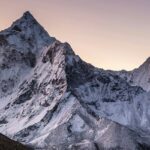Nepal is a country rich in traditions and modern festive customs that co-exist. Festivals in Nepal beautifully reflect its vibrant culture throughout the year. Due to its rich heritage, religious multiplicity and the change of seasons, the country is full of celebrations throughout the year. Famous festivals range from major Hindu holidays to commemorations of Buddhist ceremonies, leaving something for every traveller to experience. These important festivals will make your trip unforgettable, whether you are looking for a spiritual quest, a cultural encounter or simply a new adventure.
Top 10 Famous Festivals In Nepal
Here are some of the most popular festivals in Nepal that are a must-see for anyone looking to experience the country’s amazing cultural heritage:
1. Dashain
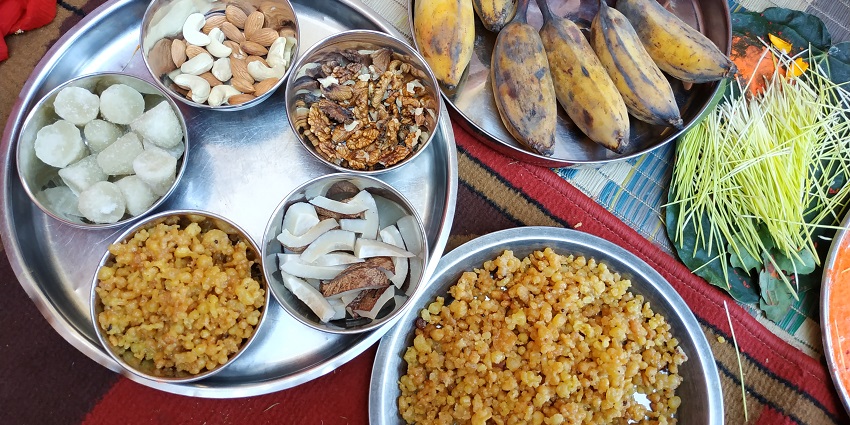
Photo: Nirajan_pant / Wikimedia Commons / Image For Representation Only
Dashain is the longest and one of Nepal’s main festivals. It honours the victory of the goddess Durga over evil and celebrates the victory of good. During this 15-day festival, families are reunited, and people travel across the country to visit their loved ones. Kite flying fills the sky, and children and adults enjoy this traditional activity. This holiday involves complex pujas (prayer rituals) with animal sacrifices in some sects. Red powder and blessings known as tika are given by elders to younger family members. Traditional swings known as ping are erected in villages.
Timings: September – October (Ashwin – Kartik in Nepali calendar)
Location: Nationwide
2. Tihar (Deepawali)
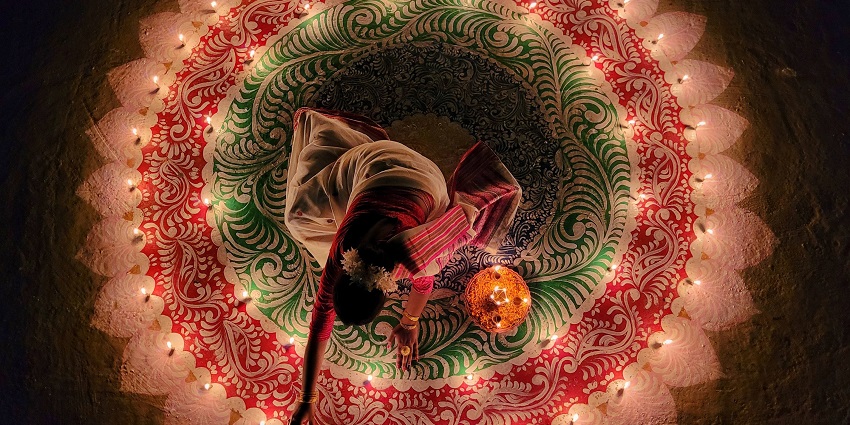
Photo: Aristeas / Wikimedia Commons / Image For Representation Only
In Nepal, Tihar is known as Deepawali and is celebrated as the festival of lights. It is celebrated for 5 days, with oil lamps, candles and colourful electric lights illuminating the country of Nepal. On each of the five days, different gods and animals are worshipped. On the first day, crows are honoured, called Kag Tihar. Dogs are honoured on Kukur Tihar, followed by Gai Tihar (cows) and Govardhan Puja. The most magical day is Laxmi Puja, when homes are decorated with lights to welcome the goddess of wealth. Last but not least is Bhai Tika, in which brothers and sisters come together to celebrate their bond with special gifts and other ceremonial routines.
Timings: October – November (Kartik in Nepali calendar)
Location: Nationwide
3. Holi (Fagu Purnima)
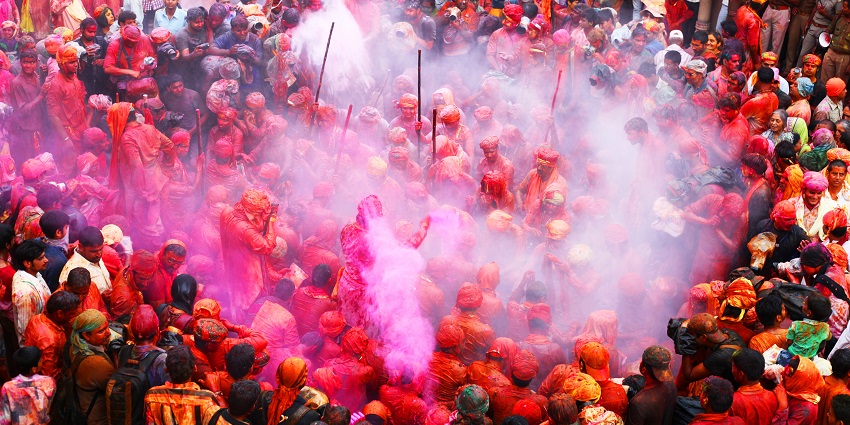
Photo: Narender9 / Wikimedia Commons / Image For Representation Only
Holi brings happiness everywhere in Nepal as people throw water and colours at each other. In Nepal, Holi is celebrated by setting up Chir Pol, a ceremonial Holi pole, in Kathmandu’s Durbar Square. People from the community gather at night to sing and dance around the bonfire. The next day begins a chaotic spectacle in which people of all ages participate in lively, playful splashes. Gujiya (sweet fritters) and Thandai (spicy milk drink) are specially prepared for the occasion, cementing Holi as one of the most popular festivals in Nepal.
Timings: February – March (Falgun Purnima in Nepali calendar)
Location: Nationwide, especially vibrant in Terai regions and Kathmandu
4. Bisket Jatra
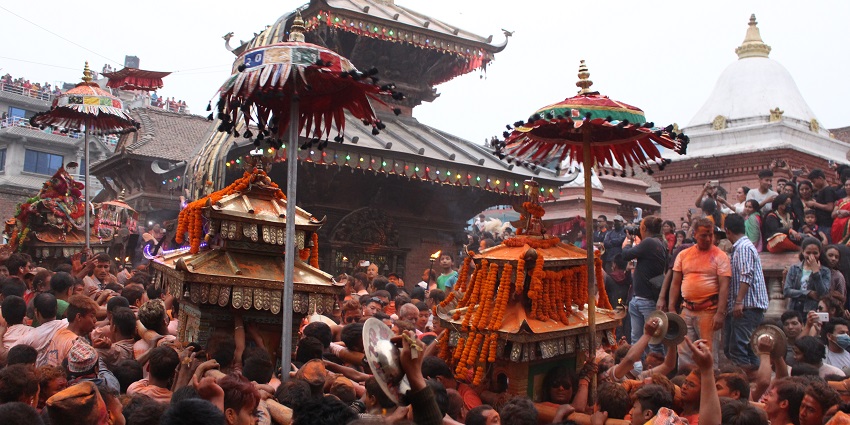
Photo: NareshKTha / Wikimedia Commons
Bisket Jatra celebrates the beginning of the Nepali New Year with a cultural festival in the historic city of Bhaktapur. The festival is a unique blend of myths, historical events and local customs, celebrated for a week. The biggest spectacle is the fierce tug-of-war between two halves of the city, in which both try to pull a huge chariot through the narrow streets. The festival commemorates the story of a ferocious snake that terrorised the city and came out of the nose of a princess. A courageous young man resolved to free the city from its terror and successfully defeated the snake. Today, tall wooden poles with serpent banners are erected and pulled down to symbolise this victory.
Timings: April (beginning of Baisakh in the Nepali calendar)
Location: Bhaktapur
5. Maghe Sankranti
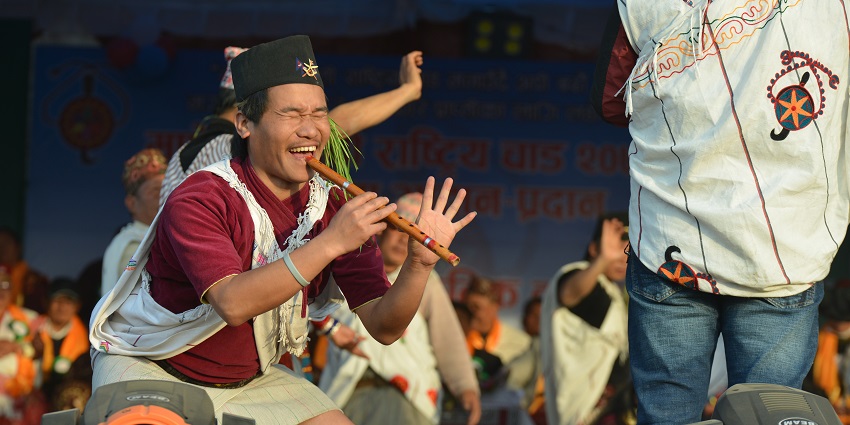
Photo: SPakhrin / Wikimedia Commons
Maghe Sankranti marks the end of the harshest month of winter while celebrating the warmer days to come. It is a special harvest festival for the farming communities of Nepal. Ritual bathing in holy rivers before sunrise is performed, which is believed to wash away sins and bring good fortune. Families prepare special food items including sesame laddus, chakki or sweet jaggery, sweet potatoes, yams and ghee. All of these foods are said to strengthen a person’s health during winter, and many families prepare them. Other households enjoy khichdi, a nutritious meal made of rice and lentils.
Timings: January (the first day of Magh in the Nepali calendar)
Location: Nationwide, especially significant in Terai regions
6. Indra Jatra
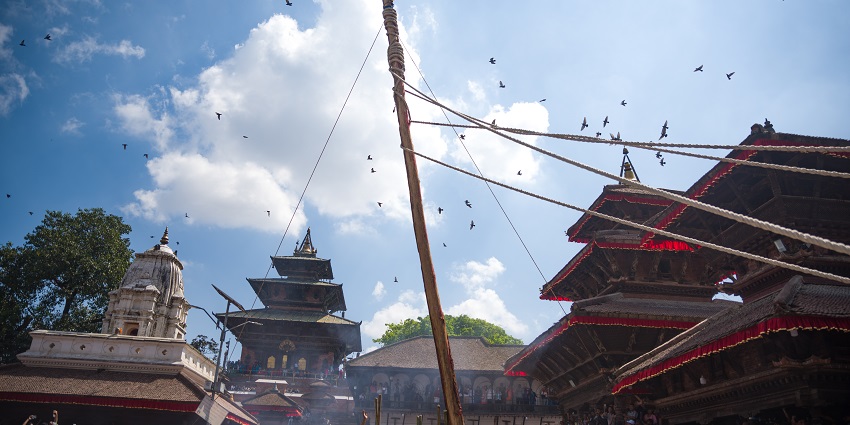
Photo: Wikimedman / Wikimedia Commons
One of the most vibrant and beautiful festivals in Nepal is Indra Jatra. It features the unveiling of Kumari, also known as the living goddess of Kathmandu. Every year, this festival marks the end of the monsoon season and includes rituals such as invoking Indra, the king of heaven and god of rain. The festival begins with the erection of a wooden pole (Yosin) at the Kathmandu Durbar Square. The most sensational part is the grand procession of assorted mask dancers who impersonate various gods and demons throughout the city. The Lakhe dance, featuring a demon with a fearsome red mask, is particularly striking, making this one of the most visually stunning cultural festivals in Nepal.
Timings: September (Bhadra – Ashwin in Nepali calendar)
Location: Kathmandu Valley, especially Kathmandu Durbar Square
7. Teej
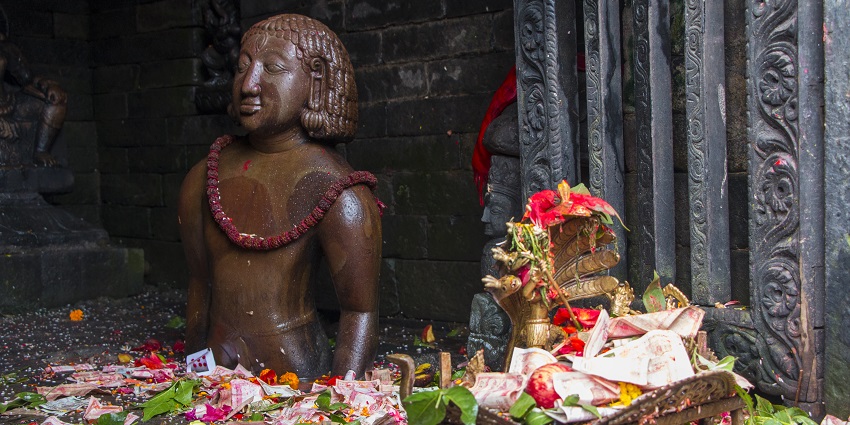
Photo: Bijaya2043 / Wikimedia Commons / Image For Representation Only
Teej symbolises the unwavering devotion, strength and unity of women in Nepali society. This colourful festival celebrated by women pays homage to Lord Shiva and Parvati and celebrates their almighty divine union. Women are seen in bright red saris and beautiful jewellery. The festival involves strict fasting, wherein some women do not eat or drink anything for the entire day. Temples of Lord Shiva are flooded by worshippers eager to make thousands of offerings and prayers. The speciality of Teej is that singing and dancing are performed during this religious ritual. For unmarried women, Teej is an occasion to pray for their dream husband, while married women pray for their husband’s good health and long life.
Timings: August – September (Bhadra in Nepali calendar)
Location: Nationwide, especially significant for Hindu women
8. Janai Purnima (Rakshya Bandhan)
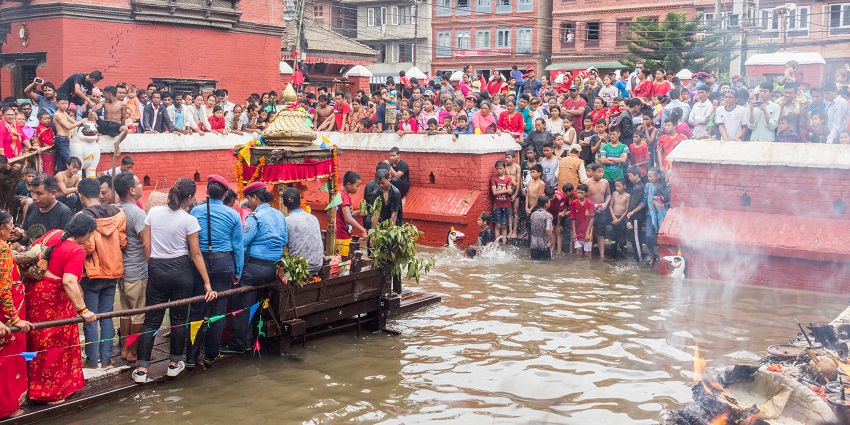
Photo: Perrine Aguiar / Wikimedia Commons
Janai Purnima combines spiritual purification as well as the celebration of the protection bond and the sacred thread. Religious Hindu men, especially Chhetris and Brahmins, celebrate the full moon day by changing the Janai (braided sacred thread) worn on their chests. As a sacred symbol of purity, devotion and faith, the Janai is worn like a thread. On this day, everyone ties colourful sacred threads called Raksha Bandhan on their wrists for protection. Climbing sacred temples and lakes is also important in the observance of other customs. Devotees from all over the world visit Gosaikunda, where bathing in the waters of the high lake located in the Langtang area is claimed to bring spiritual merit.
Timings: August (Shrawan-Bhadra in Nepali calendar)
Location: Nationwide, with special significance at Gosainkunda Lake and various temples
9. Buddha Jayanti
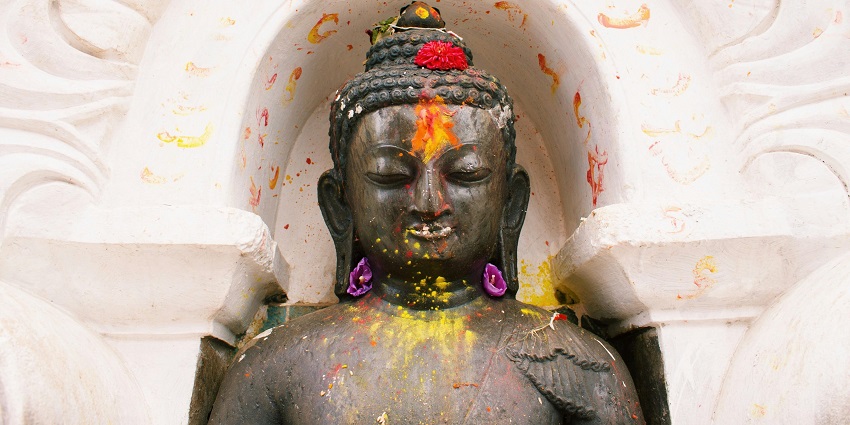
Photo: Rebecca Zaal / Pexels / Image For Representation Only
Buddha Jayanti marks the birth, enlightenment and death of Lord Buddha, who, in the Buddhist tradition, miraculously attained all three on the same day. This festival holds great significance in Nepal as Buddha’s birthplace is in Lumbini. Nepal is exceptional as it has stupas and monasteries that are wonderfully illuminated and create a pleasant atmosphere. Thousands of people visit the Swayambhunath and Boudhanath stupas in Kathmandu. Lumbini itself has become the centre of international pilgrimage. Special ceremonies and meditation sessions are held by the monks. The festival emphasises Buddha’s teachings of peace, compassion, and the middle path.
Timings: April – May (Baishakh Purnima in Nepali calendar)
Location: Nationwide, especially at Buddhist sites like Lumbini, Swayambhunath, and Boudhanath
10. Gai Jatra
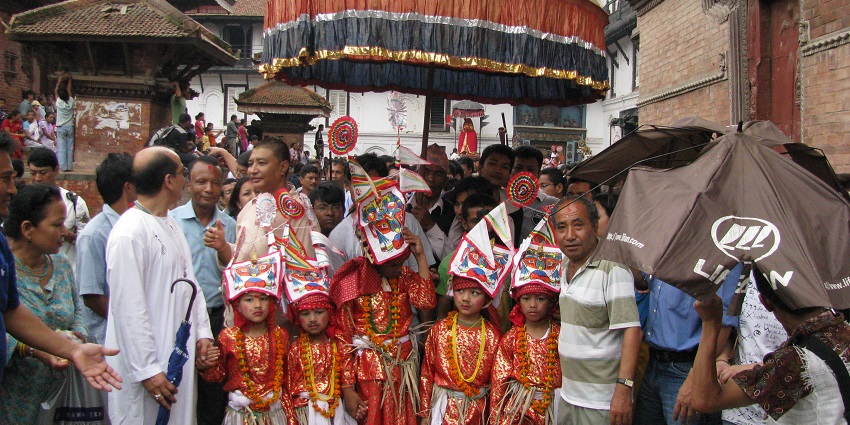
Photo: S Pakhrin / Wikimedia Commons
Gai Jatra turns mourning into a lively, unique festival in memory of those who have died in the past year. A family leads a procession with a child or young man dressed as a cow. It is believed that cows take the deceased to the afterlife, so the procession includes a cow or a person pretending to be a cow. What makes Gai Jatra different from other festivals is the use of humour and satire. The festival includes comic performances and satirical plays that often poke fun at political issues. People dress up in bizarre costumes, paint their faces, wear masks and perform other activities to entertain the audience.
Timings: August (Bhadra in Nepali calendar)
Location: Primarily in Kathmandu Valley, especially vibrant in Bhaktapur and Kathmandu
Festivals in Nepal give an insight into the country’s versatile culture and religious heritage. These festivals certainly make the day-to-day activities a spectacular spectacle filled with colour, devotion and community participation. Watching the majestic parade of Indra Jatra, participating in the colourful furore of Holi or witnessing the illumination of Tihar are some of the experiences that make Nepali festivals unforgettable. To make the most of your trip, it is best to plan your trip around the famous festivals. To witness the cultural wonders of Nepal, book your holiday with TripXL.
Cover Photo: Nrik kiran / Wikimedia Commons


 WhatsApp
WhatsApp
 Twitter
Twitter

